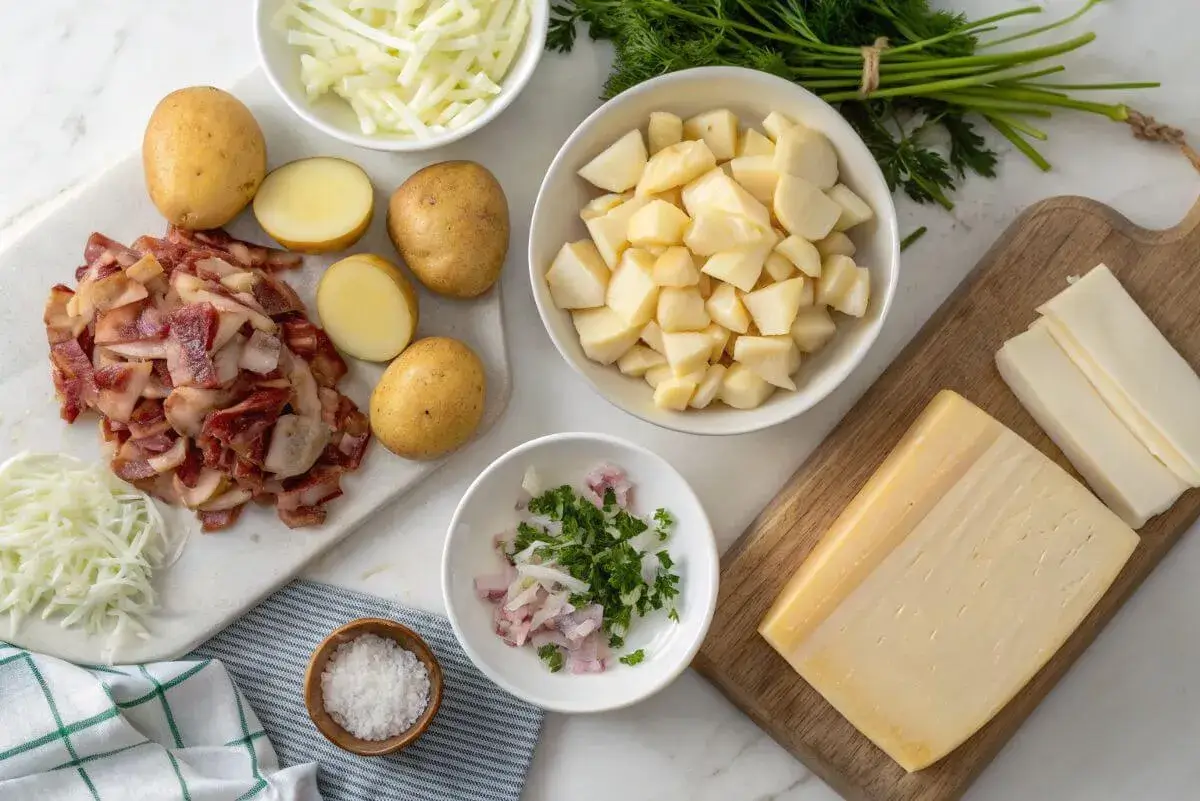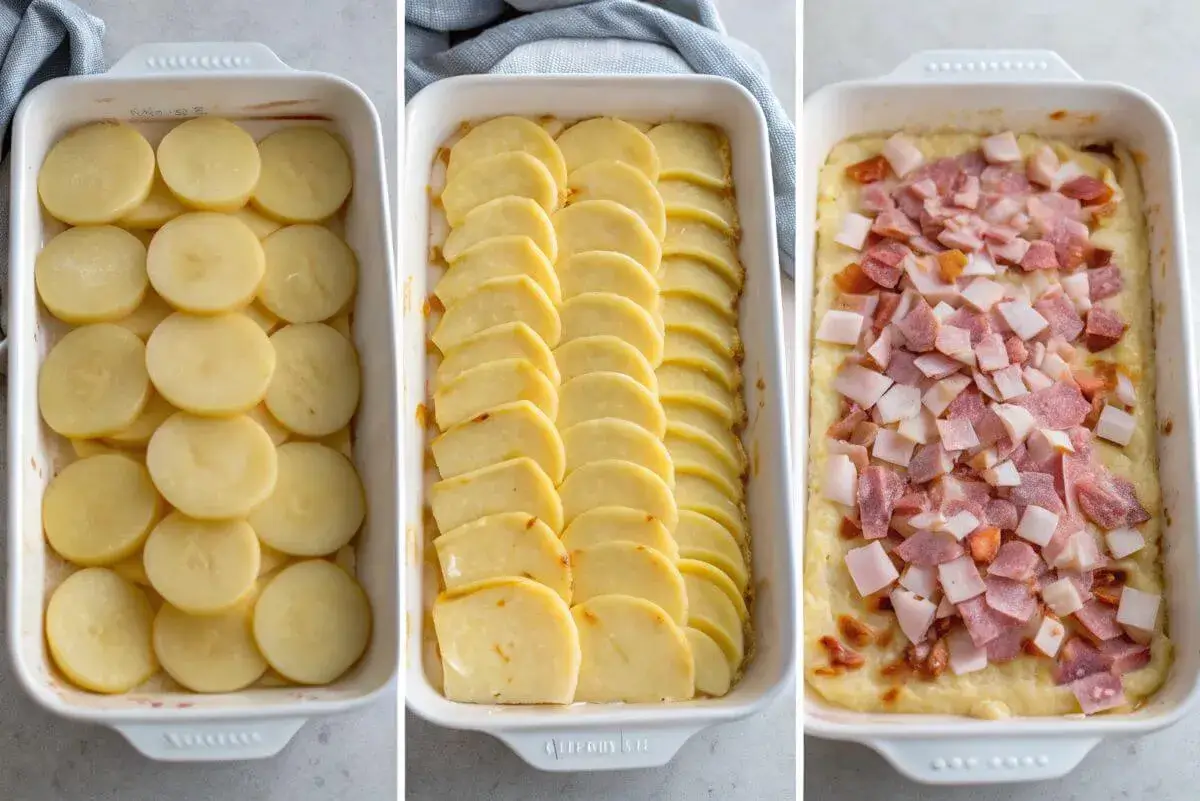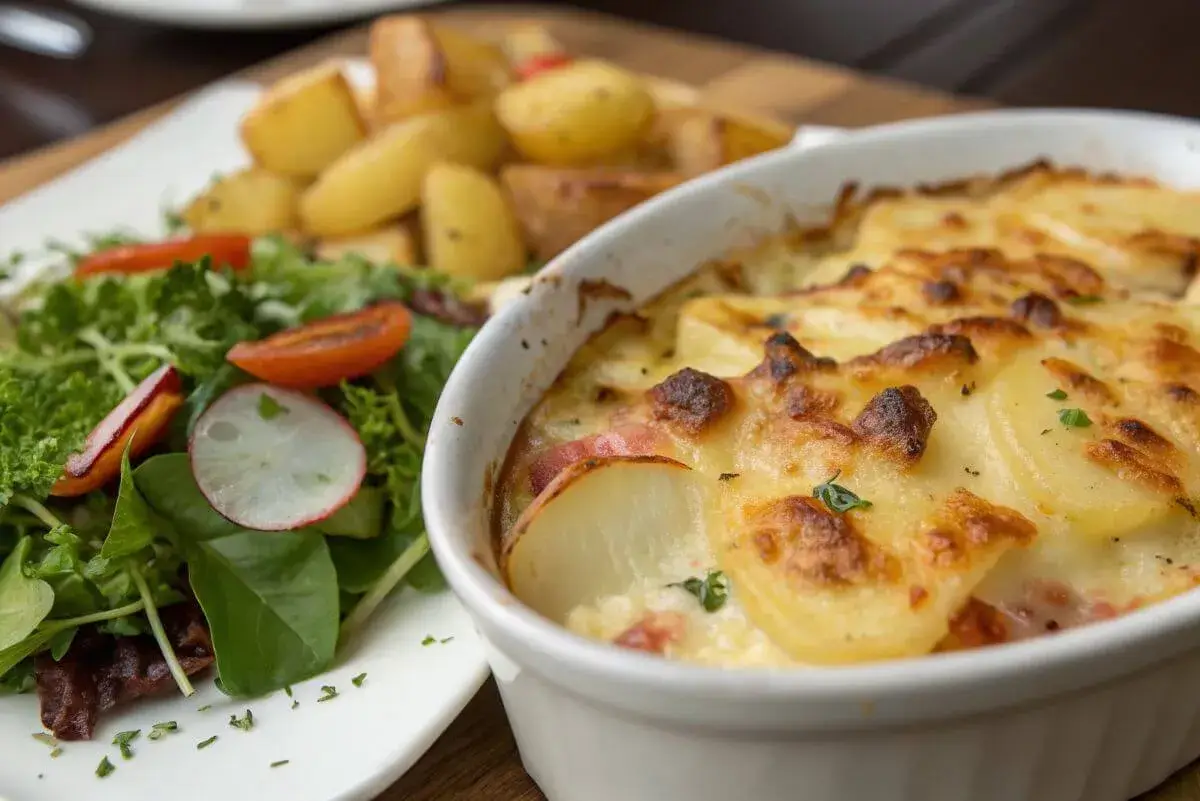Tartiflette, a dish with roots deep in the French Alps, has become a comfort food favorite among many. It’s not just about the rich, cheesy goodness; it’s a dish that tells a story of tradition, culture, and the joy of sharing good food with friends and family. In this article, we’ll explore what tartiflette is, its key ingredients, and, importantly, what tartiflette means in English. We’ll delve into its fascinating history and how it’s made, while also answering some common questions around this delightful dish. So, whether you’re a seasoned chef or just curious about French cuisine, let’s dig in!
Introduction to Tartiflette
What is Tartiflette?
Tartiflette is a hearty casserole that hails from the French region of Savoie. At the first bite, you’ll taste layers of creamy reblochon cheese, thinly sliced potatoes, smoky bacon, and often, sweet onions. It’s a dish that embodies comfort, perfect for chilly evenings or a cozy gathering with friends.
It’s important to note that tartiflette is more than just another cheesy potato dish. While it may resemble casserole-style meals you’ve encountered before, it’s unique because of the distinct flavors of its ingredients, particularly the reblochon cheese. This cheese, often melted on top, adds a velvety richness that enthusiasts adore.
The Origins and History of Tartiflette
Tartiflette’s history is quite captivating. Surprisingly, this dish isn’t ancient; instead, it became popular in the late 20th century. Originally, it was a simple meal made by farmers who needed to use up leftover potatoes and cheese. The name “tartiflette” comes from the local Savoyard word “tartifla,” which means potato.
In the 1980s, the dish was promoted by Reblochon cheese producers, aiming to revitalize interest in traditional recipes. They wanted to showcase how delicious and easy it could be to make tartiflette at home. This marketing effort paid off, and soon tartiflette was found not just in alpine lodges but also in kitchens across France and beyond.
All of this ties back to what tartiflette means in English. At its essence, it represents the heart of local French cuisine—comforting, communal, and delicious. Throughout this article, we’re going to dive deeper into its ingredients, methods, and more, bringing you closer to the heart of this beloved dish. So are you ready to discover more about tartiflette and how it fits into the culinary landscape? Let’s continue!
The Ingredients of Tartiflette
Key Ingredients Explained
To truly appreciate tartiflette, we need to look closely at its key ingredients. Each item plays a crucial role in creating that rich and comforting flavor we all crave.

First, let’s talk about the potatoes. Typically, firm waxy potatoes like Yukon Gold or Charlotte potatoes are used. They hold their shape well during cooking, providing a satisfying bite. When you slice them thinly, they absorb flavors beautifully, blending perfectly with the other ingredients.
Next up is the star of the show: reblochon cheese. This creamy, soft cheese originates from the Alps. Its rich, buttery flavor is what makes tartiflette so special. When melted, it creates a luscious layer on top of the potatoes and bacon, adding depth to every bite. If you can’t find reblochon, don’t worry! You can substitute it with other soft cheeses, like Camembert or Brie. However, the dish may taste slightly different.
Then, we have the bacon, specifically lardons. These are small strips of bacon or pork that add a savory, smoky flavor that contrasts wonderfully with the creaminess of the cheese and the earthiness of the potatoes. The saltiness from the lardons enhances the overall taste of the dish.
Onions are another important ingredient. Sautéing onions adds sweetness, balancing out the richness. They provide a layer of flavor that elevates tartiflette beyond a simple potato dish.
Finally, let’s not forget about the seasoning. A hint of black pepper, and sometimes a splash of white wine, adds a touch of acidity, which cuts through the richness of the dish. So, as you can see, every ingredient in tartiflette has its purpose. They all blend to form the hearty dish we enjoy today.
The Role of Reblochon Cheese in Tartiflette
When we specifically discuss reblochon cheese, we find it essential to the authenticity of tartiflette. This cheese is semi-soft and has a distinct, earthy flavor that takes center stage in the dish. Its creamy texture means it melts beautifully, resulting in that iconic ooze we all love.
Interestingly, uncooked reblochon has a strong aroma, but when melted, it becomes more subtle and divine. That’s why many people are drawn to tartiflette: it’s an indulgence that hits all the right notes. So, if you want to answer the question what does tartiflette mean in English? Remember that it must involve this specific cheese to embody its true essence.
As a tip, when purchasing reblochon, you might notice it costs a bit more than other cheeses. But trust me, it’s worth it for an authentic tartiflette experience. If you’re ever wondering about the cheese options you have, don’t hesitate to ask your local cheesemonger. They can guide you toward a suitable alternative if reblochon isn’t available.
How to Make Tartiflett

Step-by-Step Recipe for Tartiflette
Making tartiflette isn’t overly complicated, and it’s worth the effort. Here’s a simple recipe to guide you:
Ingredients:
- 2 lbs waxy potatoes (Yukon Gold or Charlotte)
- 1 medium onion (sliced)
- 1 cup lardons (or diced bacon)
- 1 cup crème fraîche (or heavy cream)
- 1 large reblochon cheese (about 8 oz)
- Salt and pepper (to taste)
- Butter (for greasing)
Instructions:
- Preheat the Oven:
- Begin by preheating your oven to 400°F (200°C).
- Prepare the Potatoes:
- Peel and slice the potatoes thinly (about 1/8 inch thick). Boil them in salted water for about 10 minutes until they’re just tender but not fully cooked. Drain and set aside. This step ensures your potatoes will cook evenly in the oven.
- Sauté the Onions and Bacon:
- In a large skillet, cook the lardons or bacon over medium heat until they start to get crispy. Then, add the sliced onions and cook gently until they are soft and translucent.
- Layering the Dish:
- Grease a baking dish with butter. Start by layering half of the potatoes on the bottom. Then, add a layer of the onion and bacon mixture. Pour half of the crème fraîche over this. Repeat the layers, finishing with the remaining potatoes.
- Top with Cheese:
- Finally, cut the reblochon in half horizontally and place it on top of the dish, rind side up. You can also add a bit of pepper here.
- Bake:
- Place the dish in the oven and bake for about 25-30
Tartiflette Variations
Regional Variations of Tartiflette in France
While tartiflette is best known as a classic dish from the Savoie region, many local cooks have put their unique spins on it. In various parts of France, you’ll find delightful adaptations that incorporate regional ingredients and traditions.

For instance, in the Auvergne region, some chefs like to add a touch of blue cheese to their tartiflette. This not only enhances the dish’s flavor but also gives it a rich, creamy texture. Similarly, in coastal areas, seafood enthusiasts sometimes substitute the bacon with smoked salmon, creating a lighter version that still honors the essence of tartiflette.
Moreover, some people might use different types of potatoes depending on what’s available. While waxy potatoes are traditional, using purple or fingerling potatoes can add a visual twist and a hint of uniqueness to the dish.
These variations showcase the versatility of tartiflette, proving it can adapt and thrive with the community’s culture. Each region has its own approach, fulfilling the motto that food is a reflection of its place of origin.
Vegetarian and Alternative Tartiflette Recipes
If you’re looking for vegetarian options, you’re in luck! Many cooks have created delicious meat-free versions of tartiflette that still maintain its rich textures and flavors. By swapping out the bacon for ingredients like mushrooms or caramelized onions, you can enjoy the same hearty feel.
For example, a mushroom tartiflette focuses on sautéed mushrooms, which, when combined with the reblochon cheese and spices, yield a dish that’s comforting and full of flavor. You can simply follow the same recipe as before but replace the lardons with mushrooms.
Moreover, for those who need a gluten-free option, using gluten-free bread crumbs or specially labeled potato mixes can help make a tasty alternative. Just keep in mind that you’ll need to adjust the cooking time and method slightly to achieve the perfect consistency.
As we see these variations, it’s clear that the essence of tartiflette remains the same; it’s about layers of flavor and comfort, no matter what ingredients you choose. This only deepens the question of what tartiflette means in English. It’s a cultural dish that continues to live on, evolving with time and tastes.
Cultural Significance of Tartiflette
Tartiflette in French Cuisine
Tartiflette holds a special place in the world of French cuisine. It’s more than just a meal; it’s a dish that encapsulates the spirit of winter, alpine lifestyle, and togetherness. Typically served in ski chalets, it embodies the essence of communal dining. Families or friends gather around the table to enjoy the warm, comforting flavors of tartiflette after a long day on the slopes.
In French culture, sharing a meal is sacred. Tartiflette is often made for gatherings, bringing people together in a cozy atmosphere where laughter and conversation thrive. The dish’s simplicity makes it accessible to many, allowing everyone to enjoy it, whether at a restaurant or home dinner table.
Tartiflette as a Comfort Food
When it comes to comfort food, tartiflette is an undeniable champion. Its creamy, cheesy goodness provides warmth and satisfaction, making it the ultimate dish for cold nights. Many people find themselves reminiscing about family gatherings or holiday celebrations whenever they enjoy a serving.
What elevates Tartiflette even more is its ability to adapt to personal tastes. Whether you’re adding extra spices, vegetables, or even proteins, it becomes a canvas for anyone’s preferences. Sharing these stories while enjoying a hearty plate of tartiflette only enriches the experience.
Thus, as we ponder what tartiflette means in English, we uncover its broader significance beyond mere translation. It signifies hospitality, warmth, and the joy of togetherness.
What Does Tartiflette Mean in English?
Literal Translation of Tartiflette
Initially, if we break down the word “tartiflette,” we encounter a fascinating insight into its meaning. The term “tartiflette” derives from the Savoy dialect in France, where “tartifla” refers to potatoes. This connection is quite fitting, given that potatoes are the star ingredient in this well-loved dish.
In English, we might call it “potato gratin” or simply a cheesy potato casserole. However, translating the word doesn’t quite capture the dish’s essence. You see, the joy of tartiflette lies in the combination of flavors and the tradition surrounding it, which goes beyond just potatoes and cheese.
Cultural Context and Understanding
To truly grasp what tartiflette means in English, we must delve into the cultural significance that accompanies this dish. Tartiflette embodies the cozy, communal spirit fostered in the French Alps. It’s primarily prepared as a meal to share during gatherings, especially in cold weather. The dish resonates with the lifestyle of mountain dwellers who needed hearty meals to sustain them through tough, chilly winters.
In this context, tartiflette becomes more than a simple dish—it represents warmth, hospitality, and togetherness. When people sit down to enjoy it, they are not just filling their bellies; they are partaking in a cultural experience that celebrates community and shared traditions. This sentiment is precisely what many look for when they enjoy food from different cultures.
While we can translate words, we cannot always translate feelings. When thinking about what tartiflette signifies, the closest English translation would be “comfort in a dish.” Just like the food brings warmth to the body, the cultural experience brings warmth to the heart.
FAQs about Tartiflette
Is Tartiflette the Same as Potato Gratin?
Many folks often wonder if tartiflette is just another name for potato gratin. While they share similarities, there are some key differences. Potato gratin typically includes layers of potatoes baked with cream and cheese, often without any additional ingredients. On the other hand, tartiflette features layers of potatoes, bacon, onions, and the defining ingredient—reblochon cheese.
Additionally, tartiflette is designed to be more indulgent, while potato gratin can be a lighter, simpler dish. In essence, they belong to the same family of baked potato dishes, yet they each have their unique charm.
Can You Make Tartiflette Without Reblochon?
This is a great question! While reblochon is the star of the cake, you can substitute it if it’s not available. Many people have found success using cheeses like Camembert or Brie as alternatives. Although the flavor may change slightly, the main goal is to achieve that creamy, melty goodness that makes tartiflette so delightful. So, if you’re ever caught without reblochon, don’t fret! You’re free to experiment with what you have on hand.
Conclusion: Embracing the Tartiflette Experience
As we wrap up our exploration into what tartiflette means in English? This dish is about more than just its ingredients. Tartiflette encapsulates the spirit of sharing meals with loved ones and embracing the coziness of home. Whether you’re making it for a lively gathering after a day of skiing or enjoying a quiet dinner at home, it brings warmth and comfort to the table.
The delightful combination of potatoes, bacon, and the luscious reblochon cheese makes every bite satisfying. Plus, its connection to the rich culture of the French Alps adds an exciting layer to each serving.
Inviting Tartiflette into Your Culinary Journey
If you haven’t tried making tartiflette yourself, there’s no better time than now. The recipe is straightforward, and the results are always a hit! So go ahead, gather your ingredients, and perhaps invite a few friends over to share this comforting dish. Remember, sharing food is one of the best ways to build memories and enjoy each other’s company.
In pondering what tartiflette means in English, we recognize it as a celebration of culinary tradition. It’s not just a meal; it tells a story of community, warmth, and the joy that great food brings. By embracing dishes like tartiflette, you open a door to new cultures and experiences, making your culinary journey all the more thrilling.
Summary and Final Thoughts
In conclusion, we’ve delved into the wonderful world of tartiflette, uncovering its meaning and significance. From exploring the rich ingredients to understanding the cultural roots, tartiflette is indeed an embodiment of comfort and fellowship.
A Revisit to the Essence of Tartiflette
We learned that tartiflette means more than just a hearty potato dish with cheese. It underscores the importance of communal dining and embracing local traditions. Therefore, when asking what does tartiflette mean in English? We see that it represents warmth, shared experiences, and the heart of French alpine culture.
From its origins in Savoie to the various adaptations found around France, tartiflette is a unique dish that deserves a place on every food lover’s table. Whether you’re a seasoned cook or a curious newbie, giving tartiflette a try can be a rewarding experience.
Encouragement to Try Tartiflette
So why not venture into the kitchen and join the ranks of those who have enjoyed this delightful dish? Gather your ingredients, invite your family or friends, and allow tartiflette to work its magic. You just might discover that it becomes your favorite comfort food too!
In the end, it’s all about savoring every bite, creating memories, and sharing stories, just like Anthony Bourdain would have wanted. So get ready to enjoy the spirit of the Alps right in your home!

